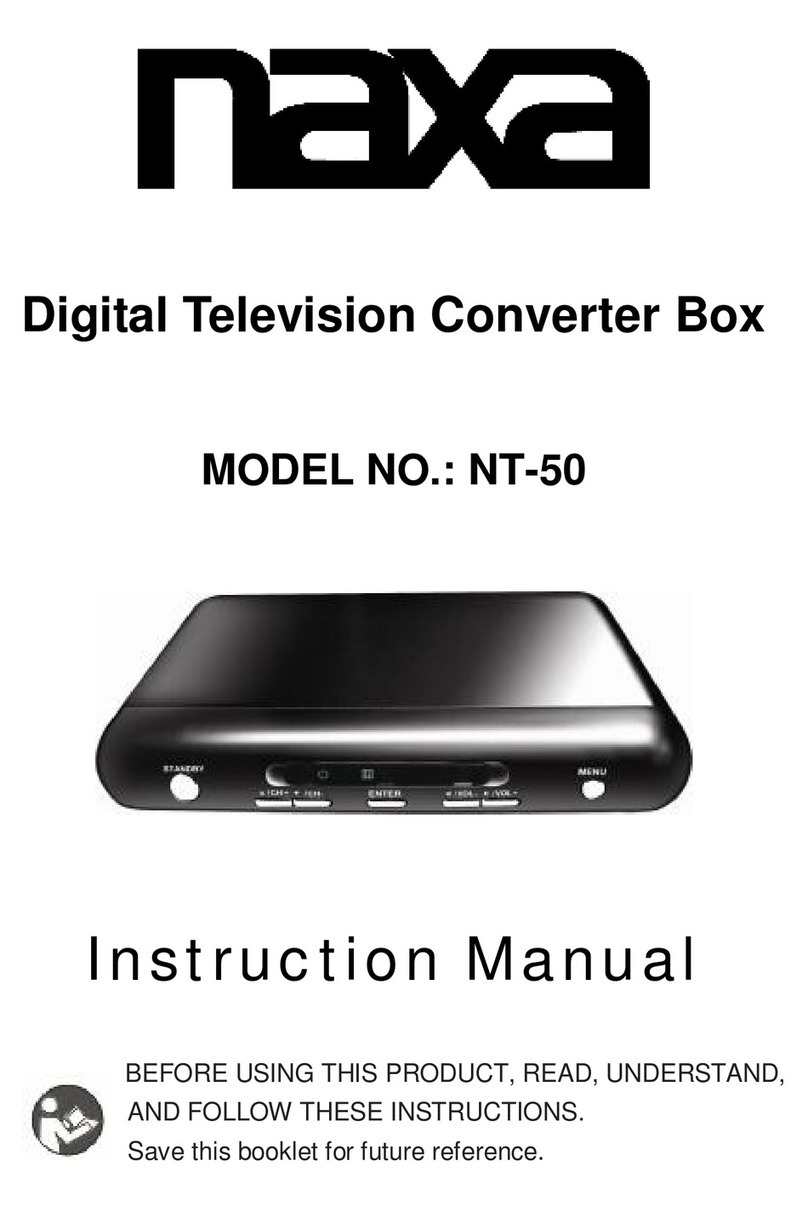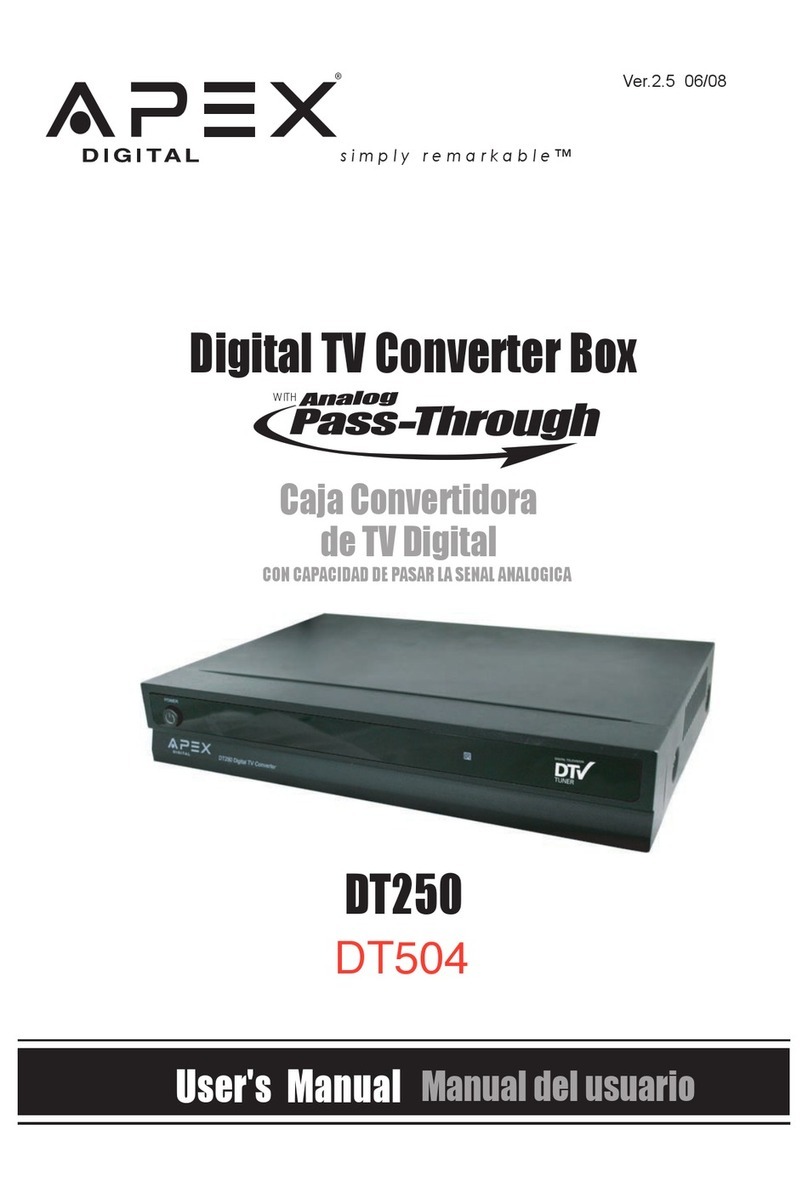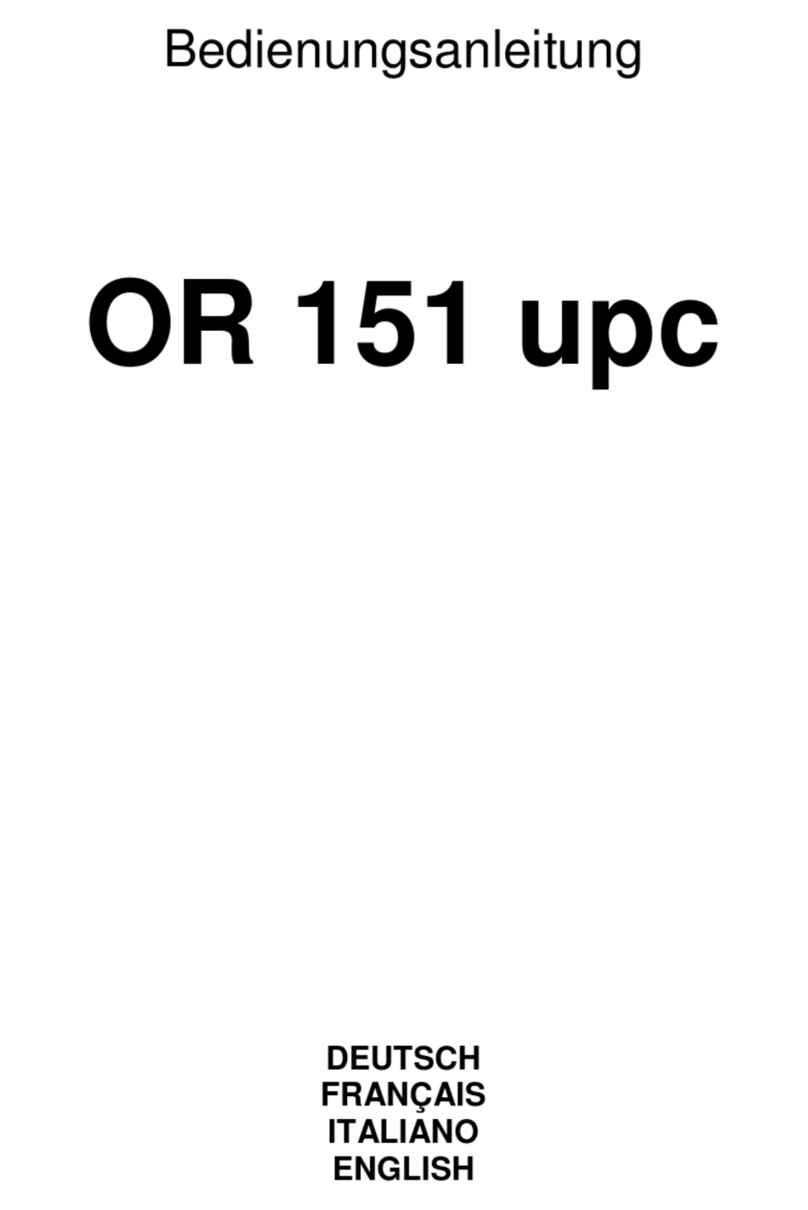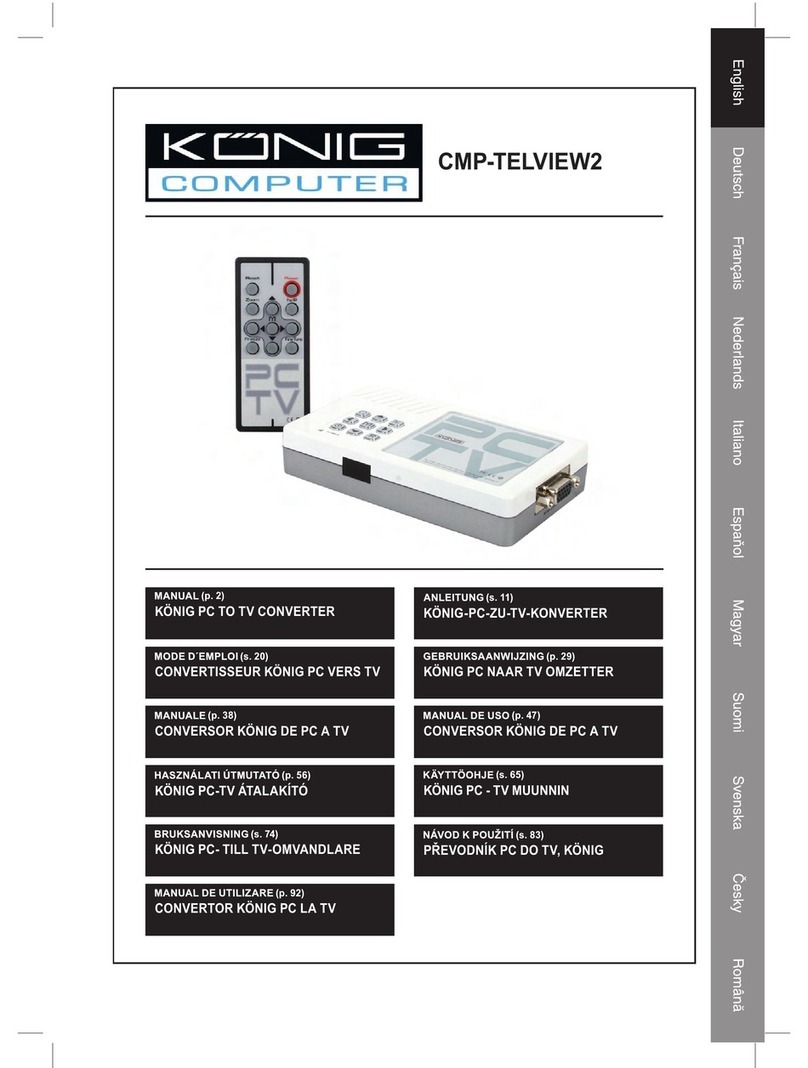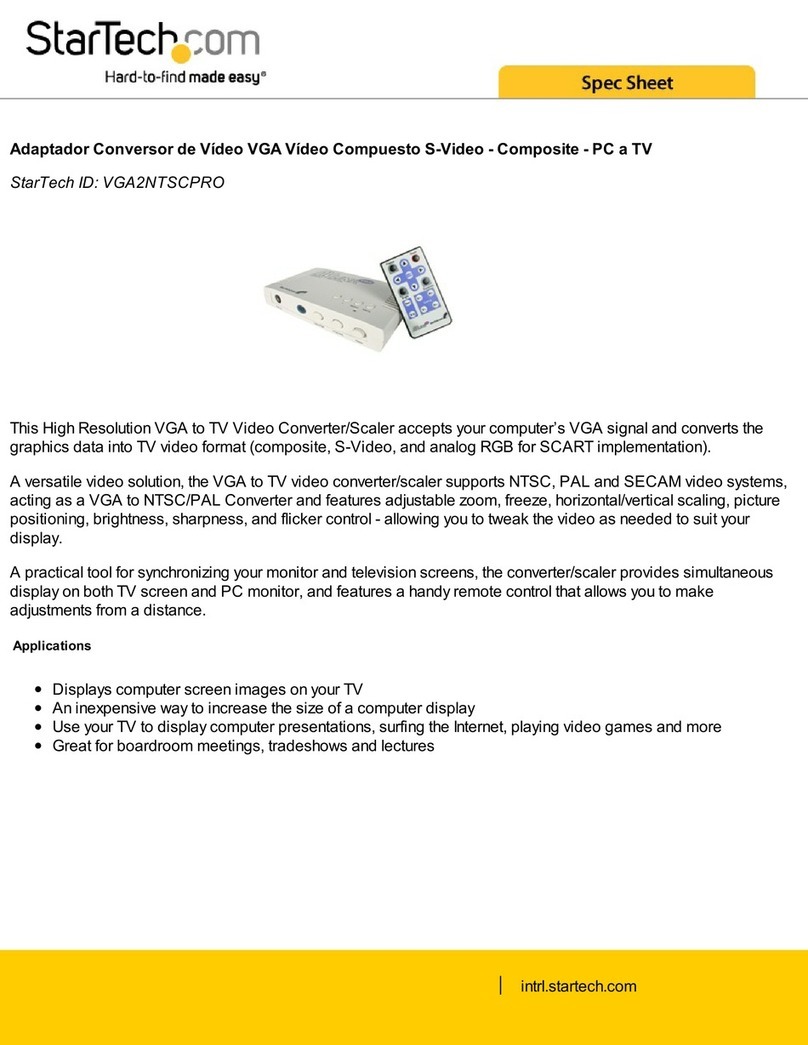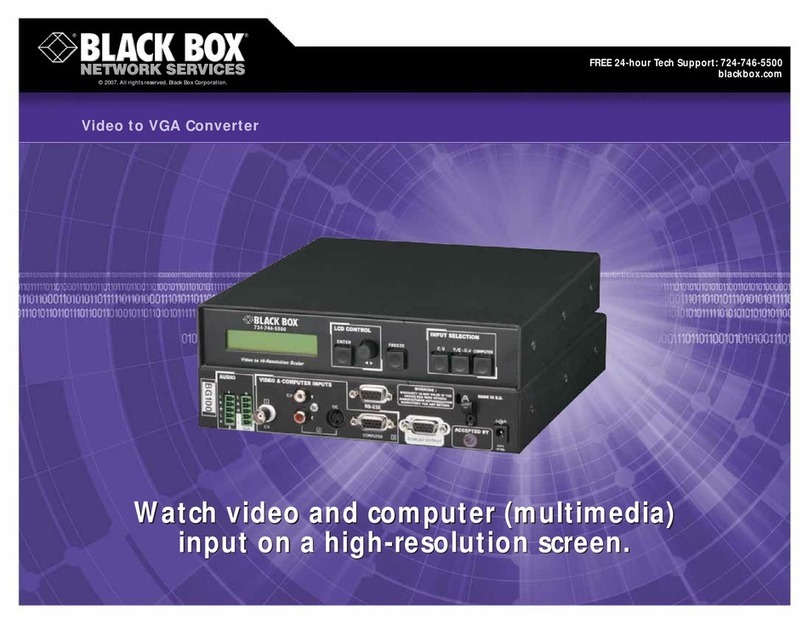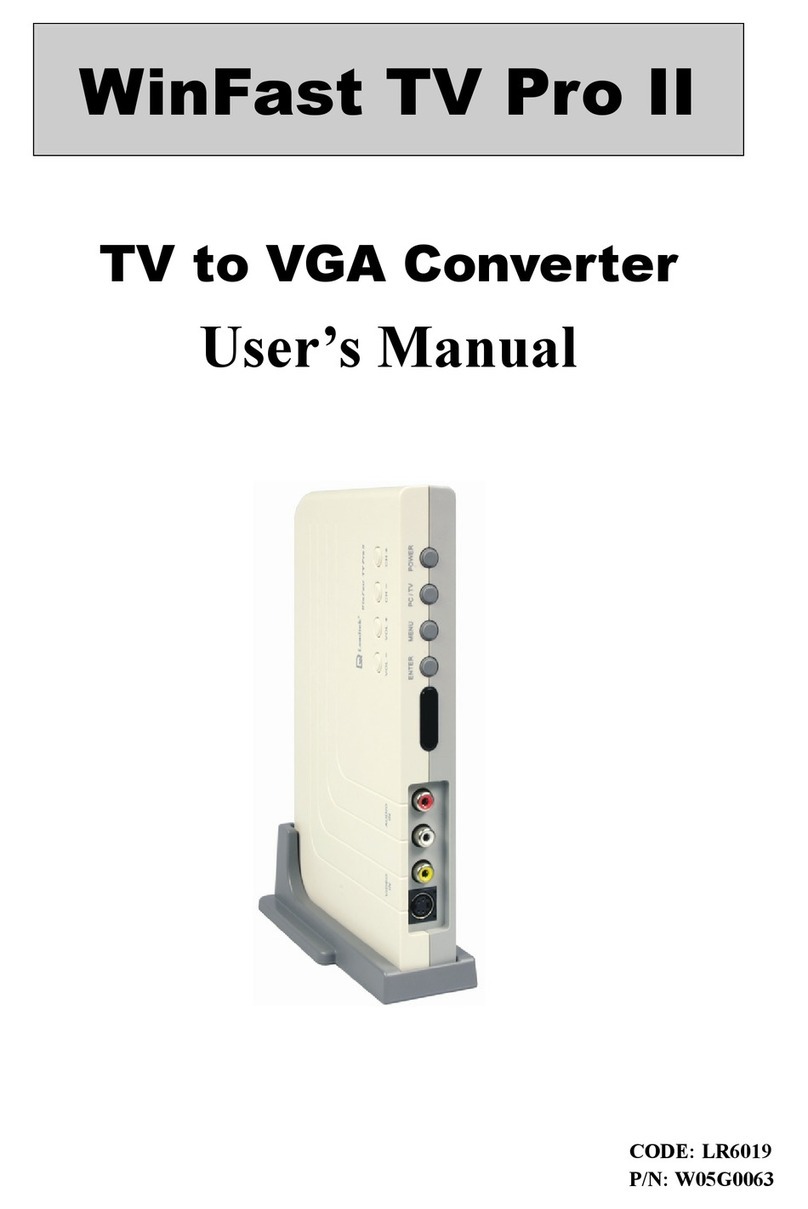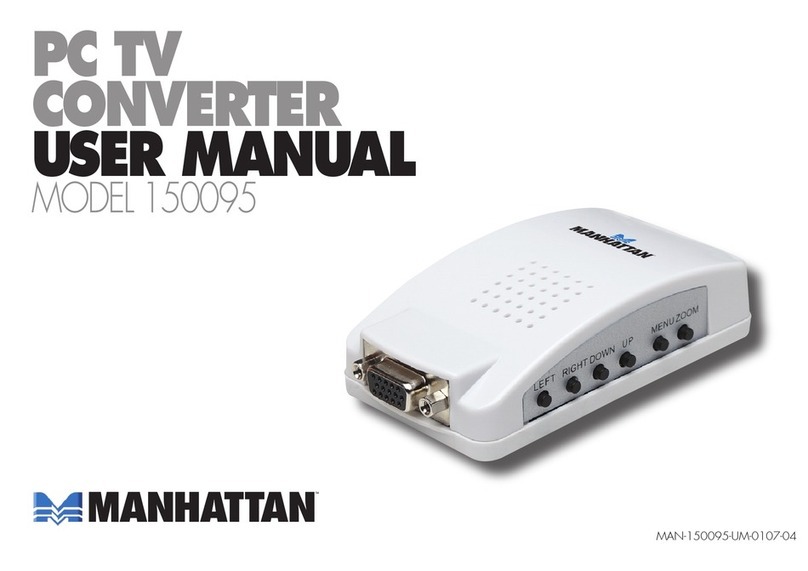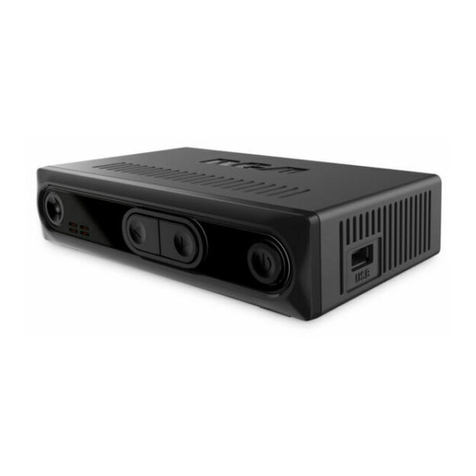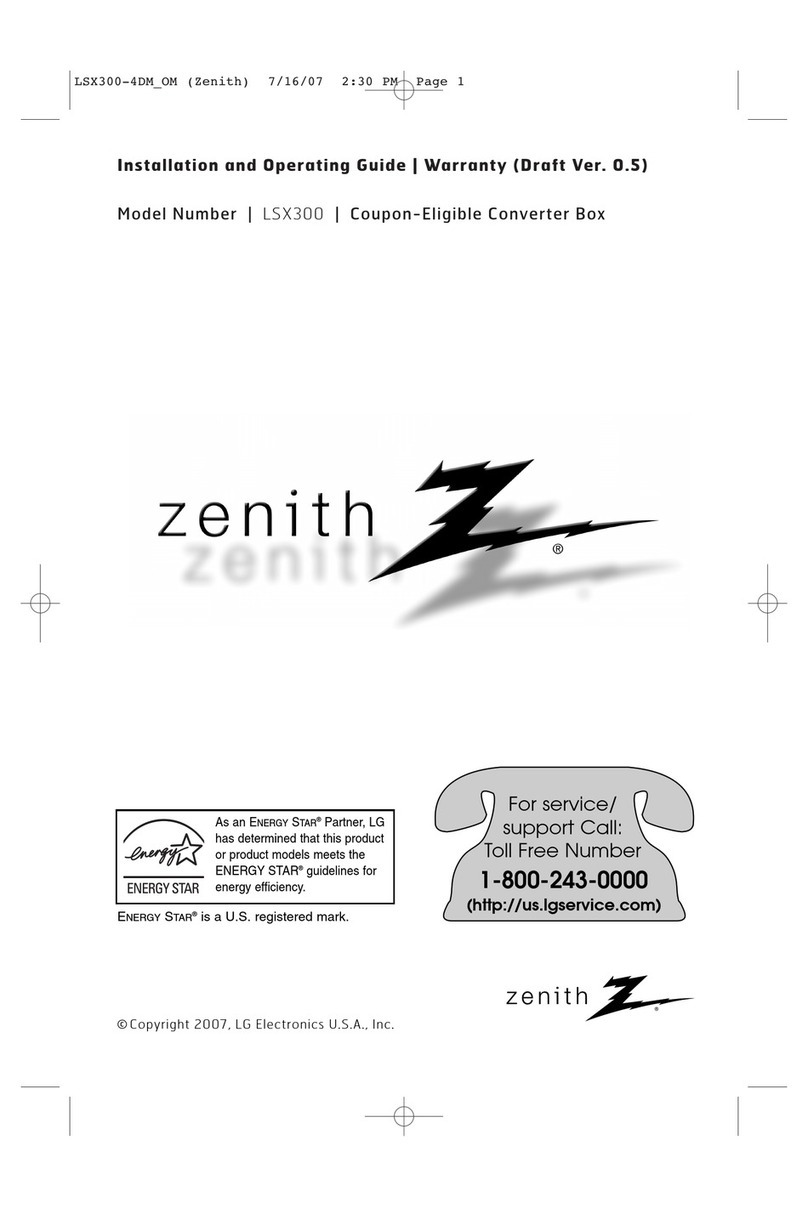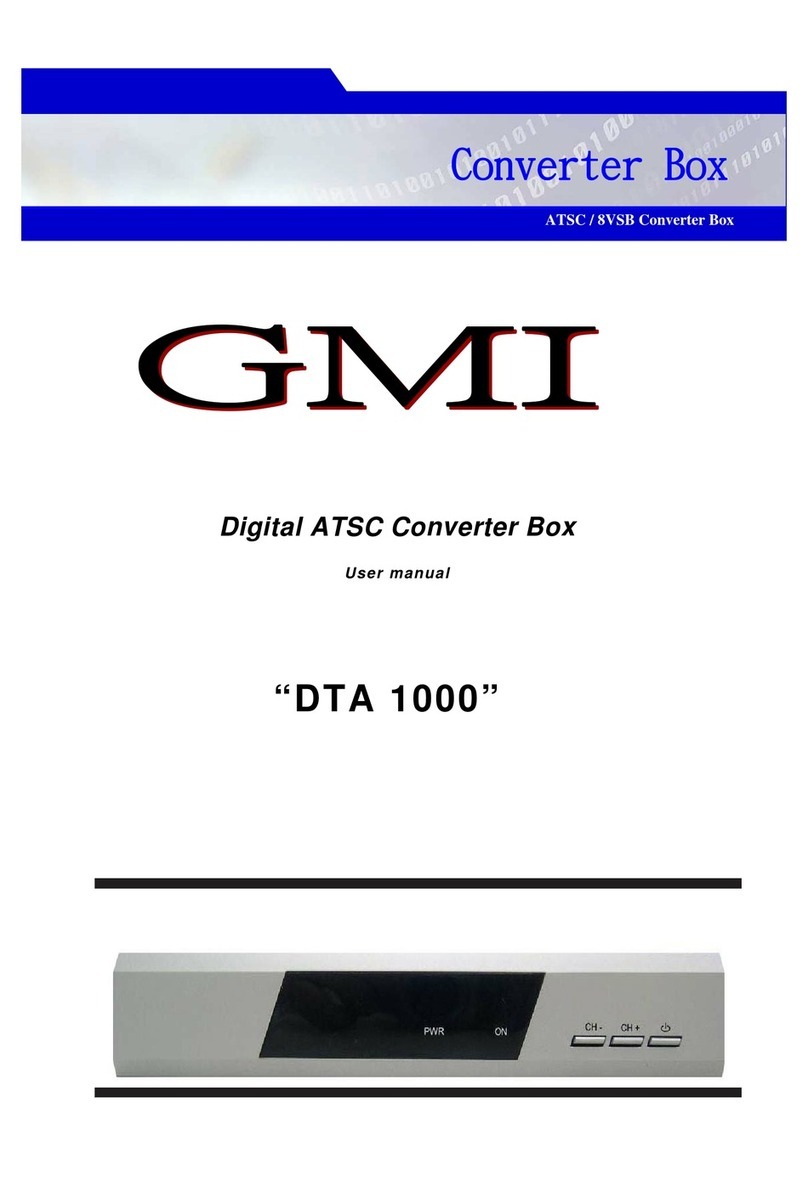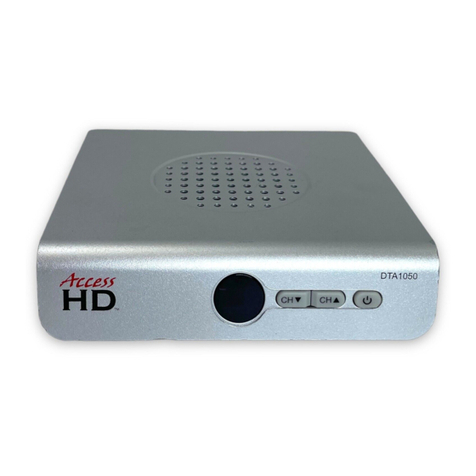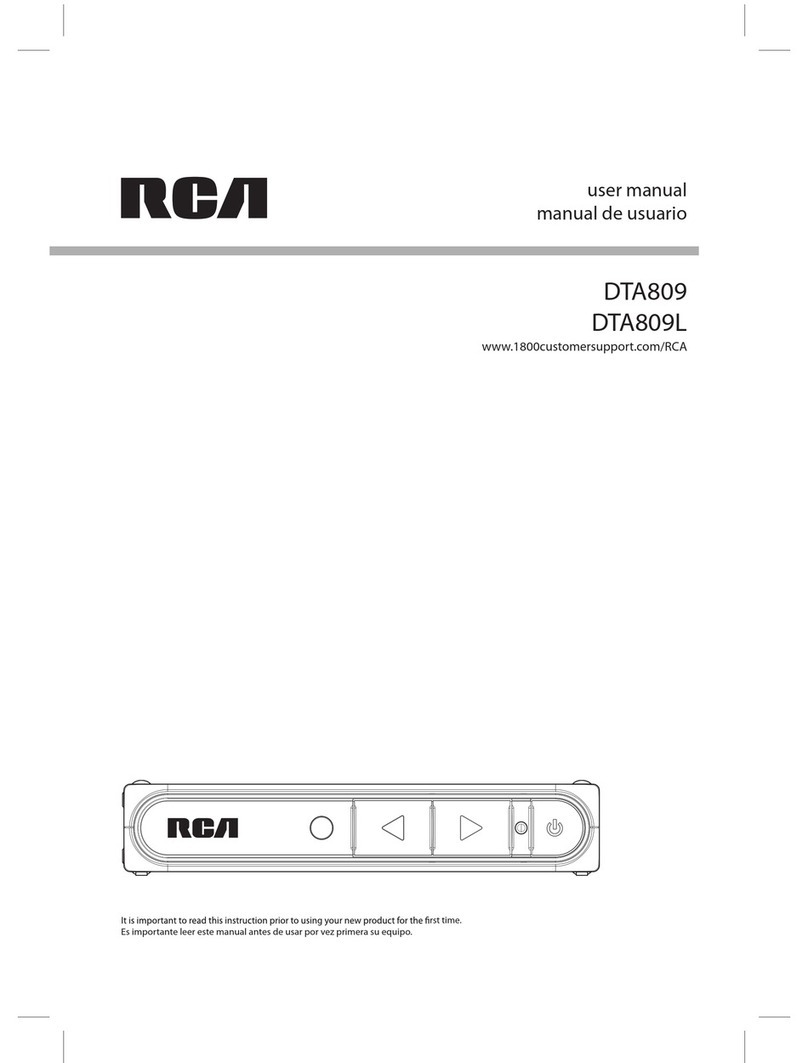EEG EN 530 User manual

HDTV SMART ENCODER IV
MODEL EN 530
EEG Enterprises, Inc.
586 Main Street
Farmingdale, New York 11735
TEL: (516) 293-7472 FAX: (516) 293-7417
Copyright (c), EEG Enterprises, Inc. 2000-2007
All rights reserved.

EN530 HDTV Smart Encoder IV
eeg
Table Of Contents
Introduction________________________________________________ 2
Product Description...........................................................................2
Features Overview.............................................................................2
Internal Block Diagram.....................................................................2
Installation_________________________________________________ 3
Front Panel ........................................................................................4
Rear Panel..........................................................................................6
Data Port Settings..............................................................................8
Encoder Operation__________________________________________ 9
Command Format..............................................................................9
HD Output Types ..............................................................................10
Local Caption Entry ..........................................................................12
XDS Insertion....................................................................................16
URL and Text Encoding....................................................................21
Additional Features _________________________________________ 24
Non-Volatile Memory.......................................................................24
Serial Port Configuration...................................................................26
GPI Switch Functions........................................................................27
Encoder Status Commands................................................................29
Appendices ________________________________________________ 31
Grand Alliance Interface ...................................................................31
RS422 Configuration.........................................................................32
Clone Port Option..............................................................................33
EN530 Specifications________________________________________ 34
References ________________________________________________ 36
Copyright 2000-2007, EEG Enterprises, Inc. All rights reserved. The contents of this
manual may not be transmitted or reproduced in any form without the written permission of
EEG.
The revision date for this manual is September 13, 2007.
©2000-2007 EEG Enterprises, Inc. 1

EN530 HDTV Smart Encoder IV
eeg
Section 1: Introduction
Product Description
The EN530 HDTV Smart Encoder IV is designed to provide an efficient and
universal solution for Standard Definition and High Definition Television
closed captioning applications. The EN530 provides HD caption insertion and
de-embedding capabilities for use in video post-production and live broadcast
captioning. A full range of features for both up-conversion and down-
conversion of caption data support automatic bridging between Standard and
High Definition formats.
The Advanced Smart Encoder IV protocol is a superset of the protocol used in
earlier industry standard EEG Smart Encoders, ensuring smooth user transition
and full software compatibility. All Line 21 functionality of the EN470 Smart
Encoder III is preserved in addition to the EN530’s advanced DTVCC
operations.
Features Overview
Receives caption input from three serial input ports, a built-in dial-up
modem, and recovery of upstream data from both HD and SD video inputs
Compliance with all FCC mandated EIA-608B and CEA-708 standards,
plus GPI closed caption relocation to satisfy emergency alert accessibility
requirements
Independent HD and SD video paths allow simultaneous encoding of HD
SMPTE 292M VANC captions and SDI SMPTE 259M Line 21 captions
Transparent up-conversion of legacy EIA-608B caption services to CEA-
708 format for HDTV
Intelligent automatic switching between HD Insertion and Recovery output
methods and multiple captioning sources
Compatible with all ATSC Encoders supporting SMPTE 334M, SMPTE
333M or Grand Alliance captioning protocols
Supports a wide variety of HD transmission and mastering formats
including 1080i, 1080p, 720p, 480p, and 24psf
©2000-2007 EEG Enterprises, Inc.
2

EN530 HDTV Smart Encoder IV
Internal Block Diagram
The following diagram depicts the internal processing paths of the EN530:
©2000-2007 EEG Enterprises, Inc. 3

EN530 HDTV Smart Encoder IV
eeg
Section 2: Installation
Front Panel
The Encoder front panel is shown in the figure below.
POWER
HDTV SMART ENCODER IV
MODEL EN530 ENCODER
ON RESET
MODE PORT DATA L21 XDS
eeg
FARMINGDALE, N.Y.
eeg
The front panel has the following controls:
POWER Turns power to the Encoder on and off.
ENCODER ON Controls relay bypass for HD Out 1 and SD Out 1. HD and SD video paths will
be untouched by the Encoder when bypass is set. The LED indicator is off
when the Encoder is bypassed.
RESET Performs a hardware reset. The Encoder will reboot, all operations will be
cleared, and status will return to the default settings stored in Non-Volatile
Memory.
©2000-2007 EEG Enterprises, Inc.
4

EN530 HDTV Smart Encoder IV
Front Panel LCD The front panel LCD displays information about the Encoder’s current and
recent operations. The top row of the display corresponds to primary caption
channel operations, and the bottom row corresponds to secondary caption
channel operations.
Mode displays an abbreviation corresponding to the Local Entry Mode that
was last entered for each captioning service. For a list of Local Entry Modes
and abbreviations, see page 12.
Port indicates the port that last input SD captioning and the baud rate at which
it is operating.
Data displays Input and Output icons that blink to indicate transmission or
reception of 608 serial data for each service. A blinking “I” indicates that the
Encoder is receiving caption data from an input port. A blinking “O” indicates
that the Encoder is inserting this data into output video signals.
L21 displays Input and Output icons that blink to indicate transmission or
reception of 608 Line 21 data for each service. A blinking “I” indicates that the
Encoder is receiving caption data from the SD video input. A blinking “O”
indicates that the Encoder is inserting this data into output video signals.
XDS displays an Output icon that blinks to indicate transmission of data. A
blinking “O” indicates that the Encoder is inserting XDS packets from its
queue into output video signals.
The rightmost column in the display indicates the presence of HD and SDI
video sources. The top row will display SDI if a video source is present at the
rear panel SD-SDI IN, and the bottom row will display HD if a video source is
present at the HD-SDI IN. If an SDI signal is connected to HD-SDI IN for SDI
VANC encoding, the HD indicator will appear.
©2000-2007 EEG Enterprises, Inc. 5

EN530 HDTV Smart Encoder IV
Rear Panel
The Encoder’s main configuration and operation is controlled through the rear
panel input ports. A connection diagram for a typical setup is shown below,
followed by a more detailed description of available options for each
connection. For more detailed descriptions of serial port operation and
configuration, see pages 8 and 26.
Line Cord AC power input.
SD-SDI In Input for serial component digital Standard Definition SMPTE 259M (SDI)
video source.
HD-SDI In Input for HD-SDI SMPTE 292M video source for VANC data recovery and
encoding. Supported HD video formats include1080i, 1080p, 720p, 480p, and
24psf.
MA Standard installed modem data port. Connect to a phone line to enable dial-up
data entry.
P1 Can be configured as a third RS232 general purpose data port or as a special
purpose CEA-708 data port supporting SMPTE 333M or Grand Alliance
protocols for connection to the captioning port of an ATSC encoder.
Configuration of this port is described in Section 3 under the “HD Output
Types” heading.
P2 General purpose serial data port for caption or XDS input. Configurable for
RS232 or RS422 operation.
©2000-2007 EEG Enterprises, Inc.
6

EN530 HDTV Smart Encoder IV
P3 General purpose serial data port for caption or XDS input. Configurable for
RS232 or RS422 operation. As the Master configuration port, P3 is the only
port that can enter some Encoder commands.
VTR (GPI) This 6-pin connector is configured as 4 unique GPI switches. The GPI switches
can be used to change caption up-conversion and down-conversion settings and
to control caption display relocation to prevent overlap with emergency
information and graphics. See page 27 for the GPI input pin-outs.
MB Optional second modem data port. Connect to a phone line to enable dial-up
data entry.
Time Code Not used
SD-SDI Out Standard Definition SMPTE 259M video output. OUT 1 is the primary output.
OUT 2 is for monitoring or other secondary use. Only OUT 1 is affected by
ENCODER ON bypass.
HD-SDI/SDI Out VANC data encoded HD-SDI SMPTE 292M video output. OUT 1 is the
primary output. OUT 2 is for monitoring or other secondary use. Only OUT 1
is affected by ENCODER ON bypass.
©2000-2007 EEG Enterprises, Inc. 7

EN530 HDTV Smart Encoder IV
Data Port Settings
The EN530 serial data input ports P2 and P3 are factory configured for RS232
protocol at 1200 baud, 7 data bits, and Odd parity. The dial-up modem is set to
operate at 2400 baud, but will also operate at 1200 baud without
reconfiguration. These default settings are adequate for most purposes. To
change any of these settings, see pages 26.
The EN530 controls the flow of data from input ports to the processing queue
using XON/XOFF handshaking protocol. XOFF will be sent when the queue is
over ¾ full. When the queue clears to ¼ full, XON will be sent. The XON and
XOFF characters are sent with a parity bit determined by the parity setting of
the port they are sent through. Hardware handshaking is not supported and
must be disabled when connecting the Encoder.
P1 is factory configured for connection to the captioning port of an ATSC
encoder that uses SMPTE 333M protocol. It can also be configured as a
standard data port (similar to P2 and P3), or to support an ATSC encoder that
uses Grand Alliance (GA) protocol. To reconfigure P1, see page 11.
Serial Input Activity While any of the EN530’s serial input ports (MA, P3, P2, and P1 if configured)
may enter data for any supported caption service, it is important to note that
multiple ports may not enter data for the same service simultaneously. When
an input port begins a local data entry mode for a service, any other port that
was previously entering data for that service will be preempted, and any further
data entered through that port will be lost. Therefore, coordination must be
exercised in multiple supplier captioning environments to avoid interference
and unintended data loss in switching.
The EN530 gives special priority to data entry from the dial-up modem. Once
MA is Off Hook and begins a data entry mode for a service, only P3 may
preempt the modem and take over data entry for that service. MA will retain
this priority until either P3 takes over or the modem returns On Hook.
©2000-2007 EEG Enterprises, Inc.
8

EN530 HDTV Smart Encoder IV
eeg
Section 3: Encoder Operation
Command Format
The EN530 command set is an extension of the industry standard Smart
Encoder command set used in the EEG 470 series encoders. Most commands
in the EN530 command set can be entered through any serial input port or
through the dial-up modem; any commands that can be entered only through
master configuration port P3 will be specially identified. Encoder commands
are recognized by a leading control code of <CTRL+A>, also represented by
the ASCII hex code 01. The <CTRL+A> character is non-printing on most
terminal screens, but on some it appears as a smiley face. An Encoder control
command must end with a carriage return, which can be entered with the
<ENTER> key on a keyboard or by 0D in ASCII hex.
To send the encoder commands through the serial input ports, connect a
standard 9-pin cable between your PC’s serial port and the RJ11 to DB9
adapter shipped with the EN530, and then connect the other end of the adapter
to any encoder data port. You can now send commands to the encoder, from
your PC, using a communications application such as HyperTerminal, which is
bundled with most versions of Windows. The most basic Smart Encoder
command, useful for checking the operation of your communication setup, is
<CTRL+A>?<ENTER>. If your setup is working correctly, the Encoder will
respond with its model name, firmware version, and serial number. If you have
trouble communicating using HyperTerminal, always check to make sure that
the settings in the Port Settings menu in HyperTerminal match the settings for
the Encoder port you are connecting to.
In this manual, Encoder commands will be distinguished from other text by use
of a bold font. The parameters for each command will be listed in italics.
Optional parameters will be enclosed in square brackets. Possible parameter
values and default settings will be described in text or bullet points after the
command is introduced.
©2000-2007 EEG Enterprises, Inc. 9

EN530 HDTV Smart Encoder IV
HD Output Types
The EN530 is capable of outputting HD caption data in three different ways.
The HD output type you will want to use will be determined based on the
EN530’s placement in your broadcast or post-production video path, and
sometimes the protocols supported by the equipment it is interfaced with.
HD VANC Insertion In HD VANC Insertion, the EN530 inserts its EIA-708B caption output data,
either regenerated data from the HD input, up-converted data from the SD
input, or locally-inserted data from the data ports, into the vertical ancillary
space of an HD video source, using SMPTE 334M protocol. The newly
captioned HD video signal appears at the HD-SDI video outputs on the rear
panel.
The Encoder’s default HD output mode will be VANC Insertion unless the P1
port is connected to an ATSC encoder supporting the SMPTE 333M protocol.
The Encoder will return to VANC insertion mode if the device supporting
SMPTE 333M is disconnected. VANC insertion can also be disabled by typing
<CTRL+A># OFF <ENTER>. If insertion is disabled through this command,
it must be re-enabled using <CTRL+A># ON <ENTER>. The command to
return to VANC insertion with automatic SMPTE 333M detection on P1 from
another mode, or to change the VANC line on which insertion takes place is
<CTRL+A>f 334 [Line] <ENTER>. To enter VANC Insertion mode without
automatic 333 detection, use <CTRL+A>f vanc [Line] <ENTER>. This will
allow P1 to be used as a general purpose serial input port.
The optional Line parameter sets the VANC line on which caption data will be
inserted into the HD video signal. Non-captioning VANC data packets on that
line will be preserved. The following table lists the valid VANC insertion lines
for the most common HD video formats. The Encoder’s default insertion line is
the first available VANC line of the particular video standard, which is valid
for all formats. Entering 0 as the Line parameter will set insertion for the first
available VANC line, using the order listed in the table below for each format.
In interlaced formats, caption data will only be inserted once per frame, in the
first field.
©2000-2007 EEG Enterprises, Inc.
10

EN530 HDTV Smart Encoder IV
Format VANC Insertion Lines
24Psf 9-20
720p 9-25
1080i 9-20
SD 12-20
333 Serial Output In 333 serial output, the EN530 sends its 708 caption output to a serial output
queue for transport to an ATSC encoder supporting SMPTE 333M protocol.
333 is a “pull” protocol; the ATSC encoder sends synchronization requests
(SYNs) to the EN530, which then sends the requested data bytes out through
serial port P1. The SMPTE 333M specification should be referred to for
complete information about the protocol.
To set the EN530 for 333 serial output, simply connect P1 to the captioning
port of a SMPTE 333M ATSC encoder. When the EN530 begins receiving
SYNs it will automatically begin 333 output. P1 is default configured for the
proper communications settings for 333 (38400 Baud, 8 data bits, no parity,
and one stop bit). The command to manually set the Encoder for 333 output
and set P1 to the proper settings is <CTRL+A>f 333 <ENTER>.
GA Serial Output In GA serial output, the EN530 sends its 708 caption output to a serial output
queue for transport to an ATSC encoder supporting Grand Alliance (GA)
protocol. Grand Alliance is a “push” protocol; the EN530 sends data out
through P1 as it becomes available, and the ATSC encoder synchronizes the
data upon reception. The Grand Alliance transport protocol in use by EEG
equipment is described on page 31 of this manual.
Since the Encoder initiates data transfer with a Grand Alliance ATSC encoder,
GA output must be initialized manually. The command to set the Encoder for
GA output is <CTRL+A>f ga <ENTER>. This command will begin the GA
serial output operation and set P1 for the proper communications rate (19200
Baud, 8 data bits, no parity, and one stop bit).
Each time the EN530 is power cycled, it will automatically return to VANC
Insertion output mode. If a SMPTE 333M ATSC encoder is connected to P1,
however, 333 serial output will begin as soon as SYNs are received. If GA
serial output is always desired, the GA output initialization command should
be stored in Non-Volatile Memory to reduce setup time. If the command is
stored in NVM, GA output will automatically begin each time the Encoder is
power cycled. To write a command to NVM, see page 24.
When either 333 or GA serial output is engaged, no VANC caption data
will appear on the HD video output.
©2000-2007 EEG Enterprises, Inc. 11

EN530 HDTV Smart Encoder IV
Local Caption Entry
Data entered locally into the EN530 must be associated with a particular Line
21 Data Channel, NTSC field, or HD caption Service. The table below
identifies the commonly used NTSC (SD) Line 21 data channels.
Data
Channel Description
CC1 Primary language Closed Captioning in
Field 1
CC2 Secondary language Closed Captioning
in Field 1
CC3 Secondary language Closed Captioning
in Field 2
T1, T2 Field 1 Text services, including
Interactive TV URLs
XDS Extended Data Services such as
Program Rating, Type and Length.
Appears in Field 2.
In HD captioning, Services are designated instead of Channels. Service 1 is
assigned for primary language captioning, and Service 2 is assigned for
secondary language captioning. When 608 data is up-converted to create 708
data, CC1 data is assigned to Service 1, and CC3 data is assigned to Service 2.
Text and XDS data is not up-converted.
Local Entry Modes
The Local Entry Modes described in this section should be used for local
insertion of data into caption channels only; see the next two sections for
modes to insert Text or XDS data. In all local entry modes and upstream
regeneration, caption data is by default up-converted and down-converted as
necessary to produce matching caption displays on the HD and SD outputs.
The use of local entry modes is completely independent from the HD output
type, which for any of the entry modes described may be either insertion onto
the HD video output or serial output to an ATSC encoder.
©2000-2007 EEG Enterprises, Inc.
12

EN530 HDTV Smart Encoder IV
Regeneration Mode Appears on front panel display as REGEN. Upstream regeneration is used
whenever no local entry mode is in effect for a caption channel. The Encoder’s
default Regeneration action is to strip both the SD and HD video of upstream
captioning, and then regenerate the caption data recovered from the HD video
input on both outputs. If no upstream HD captioning is present, caption data
from the SD video input will be used instead.
The default Regeneration response is configurable by using the commands
listed in this section, and also by setting the Block 608 Up-conversion GPI
switch (see page 27).
Regenerate Upstream VANC <CTRL+A>! [ON/OFF] <ENTER>
Instructs the Encoder to either detect and potentially regenerate (default) or
ignore incoming VANC data from the HD video input. If the encoder is set to
ignore upstream VANC data, output signals will include only caption data
recovered and regenerated from the SD video input. Use OFF to ignore
upstream VANC caption data, and ON to resume detecting upstream VANC
caption data.
Ignore Upstream L21 Channel <CTRL+A>6 Channel <ENTER>
Return Upstream L21 Channel <CTRL+A>7 Channel <ENTER>
Instructs the Encoder to ignore incoming Line 21 data from the SD video input
in the specified caption channel. When Line 21 data in a channel is ignored,
output signals will not contain any caption data recovered from the SD video
input in that channel, even if there are no other data sources available.
Channel sets the incoming Line 21 channel to be turned off. This
parameter may be set for any NTSC Caption or Text channel. Upstream
XDS data cannot be turned off with this command.
708 Down-conversion <CTRL+A>h [ON/OFF] <ENTER>
Use the 708 Down-conversion command to set whether or not 708 caption data
recovered from the HD video input is down-converted and encoded to the SD
video output. The default down-conversion setting varies based on the
firmware version of your Encoder. Enter the command without a parameter to
check the current setting.
©2000-2007 EEG Enterprises, Inc. 13

EN530 HDTV Smart Encoder IV
Begin PassThru Mode <CTRL+A>3 [Pairing] [Field]<ENTER>
End PassThru Mode <CTRL+C>
Displayed as PTHRU. When a port enters the command to begin PassThru for
a field, caption data received through that port will replace upstream caption
data for that field in the SD and HD outputs. PassThru mode is for use with
complete EIA-608 formatted data streams, including control and formatting
codes, such as would be provided by captioning software packages. If
PassThru is engaged but no valid data is being entered, pairs of null data bytes
(80h 80h) will be inserted into output signals. When PassThru mode is ended,
the field will return to upstream Regeneration.
Field specifies which NTSC field the locally entered caption data is
intended for. Field 1 (enter as F1) is for primary language captioning and
text, and Field 2 (F2) is for secondary language captioning and text. The
parameter defaults to Field 1.
Pairing can be set using integer values from 1 to 4 corresponding to
differing levels of control code processing. The table below describes the
available levels. If the parameter is not set, the default for field 1 is level 4,
and the default for field 2 is level 2.
Control Code Pairing Settings
1 All incoming data is passed. Control byte pairs will not be
automatically aligned, which may lead to missed codes.
2 Field 2 default. Control pairs are identified and delayed if
necessary for correct alignment.
3 Control pairs are corrected for proper alignment and
doubled in Field 1.
4 Field 1 default. Control pairs are corrected for proper
alignment, doubled in Field 1, and non-Line 21 codes are
omitted.
©2000-2007 EEG Enterprises, Inc.
14

EN530 HDTV Smart Encoder IV
Begin RealTime Mode:<CTRL+A>2 [Channel] [Rollup][bBase] <ENTER>
End RealTime Mode: <CTRL+C>
Displayed as RTCAP. When a port enters the command to begin RealTime
mode, text entered through that port will be encoded into a rollup caption
display and replace upstream caption data for the specified channel in the SD
and HD outputs. The EN530 will automatically create all necessary control and
formatting codes. When RealTime mode is ended, the channel will return to
upstream Regeneration.
Data entered in RealTime must be in ASCII text format with a carriage return
(0Dh or <ENTER>) at the end of each line of data. Because a line of data is
processed only upon receipt of a carriage return, text may be edited by use of a
backspace (08h or <BACKSPACE>) at any time before the carriage return.
The input text may be formatted to fit on 32 character lines by sending a
carriage return at word boundaries approaching the 32 character limit. If
sufficient data to fill a line is not available within a reasonable amount of time,
a carriage return should be sent to ensure timeliness for the queued data.
Channel specifies which NTSC caption channel the ASCII data that will
be entered is intended for. Enter CC1 for primary language captioning or
CC3 for secondary language captioning. If no parameter is entered, CC1
will be assumed.
Rollup sets the number of rows in the rollup caption display that will be
created. Possible values are 2, 3, and 4. If no setting is entered, 3 will be
assumed.
Base sets the row from which the caption display will begin rolling up. The
parameter value must be entered with a leading “b”. Possible values range
from b2 (top of the screen) to b15 (bottom of the screen). The default value
is b15. Always set the Base value at least as large as the number of rows in
the rollup display, or else the uppermost row(s) of the display will not be
visible.
©2000-2007 EEG Enterprises, Inc. 15

EN530 HDTV Smart Encoder IV
XDS Insertion
Extended Data Services (XDS) is an NTSC Field 2 data channel that provides
information to viewers about the program that is being aired. On SD
broadcasts, XDS is used to transmit program ratings to allow viewer V-chip
filtering of mature content. Although HD broadcasts do not use XDS for V-
chip compliance, XDS data must still be included in compatibility bytes for set
top down-conversion.
The EN530 includes all of the XDS functionality of the broadcast industry’s
leading XDS solution, the EN470 Smart Encoder III. XDS data packets can be
loaded into the Encoder’s queue with one simple command, and be held for
any specified time period. Each individual packet type can be independently
set for upstream or local priority, and permanent packets can be stored in Non
Volatile Memory and inserted automatically whenever the Encoder is
operating.
Packets are inserted into output video signals using EEG’s proprietary
Stochastic Scheduling Algorithm. The Stochastic Scheduling Algorithm is a
finely tuned solution to the Field 2 bandwidth limitations that cause difficulties
in XDS packet transmission. A Priority level is automatically assigned to each
packet based on its XDS Class and Type. The Stochastic Scheduling Algorithm
ensures both that high priority packets like V-chip data and program names are
transmitted frequently enough to be instantly accessible for new viewers, and
that lower priority packets are guaranteed to be inserted periodically, and not
preempted completely.
As per EIA-608B specifications, all available Field 2 space is filled,
rescheduling and regeneration are automatically performed on all upstream
packets, and packet continuations are applied when necessary. Additionally,
upstream XDS program packets will continue to transmit for five minutes after
any non-clearing upstream interruption, such as a commercial break or
undesired outage.
Enable XDS Entry <CTRL+A>O XDS O <ENTER>
This command must be entered to enable a port for XDS input. A port must be
enabled for XDS input in order to accept XDS data and control commands.
The character repeated in the command is a capital o and not a zero.
©2000-2007 EEG Enterprises, Inc.
16

EN530 HDTV Smart Encoder IV
Load XDS Packet <CTRL+A>P Packet Duration Content [Priority] <ENTER>
Creates an XDS packet and loads it into the XDS queue. The Encoder will
begin inserting the packet immediately.
Packet sets the XDS Class and Type of the packet that will be created. If a
new packet is loaded with the same Packet ID as an existing packet in the
queue, the pre-existing packet will be deleted; if the new packet is a
Program Name or Program ID packet, all program-specific packets will be
deleted from the queue. A packet loaded into the Encoder with the Load
XDS Packet command has local priority; in output signals, it will replace
all upstream packets of the same Class and Type.
The Packet parameter should be entered as Class immediately followed by
Type in the way shown in the table below. Leading zeroes may be omitted.
The Class and Type of a few of the most commonly used XDS packets are
shown in the following table; for a complete list refer to EIA-608B.
Class/Type Content Class/Type Content
0102 Current Program Length 0501 Network Name
0103 Current Program Name 0502 Station ID (Call Letters)
0105 Current Program Rating 0504 TSID
Duration sets the transmission duration of the newly created packet. When
a packet’s duration period expires, it will be deleted from the XDS queue.
A duration setting of –1 will cause the packet to be inserted until it is
deleted by a future command. An integer setting (i.e. 100) will be
interpreted as the number of times to output the packet before deleting it.
An Elapsed Time setting (i.e. 00.45.00), will cause the packet to be inserted
for that length of time, beginning when the command is entered, and then
deleted.
Content sets the information content of the packet. Content can be entered
in ASCII text enclosed in curly braces, { }, or in ASCII Hex notation. A
checksum need not be enclosed, as the Encoder will calculate it
automatically before insertion.
©2000-2007 EEG Enterprises, Inc. 17

EN530 HDTV Smart Encoder IV
Priority is an optional parameter that allows the output priority of a packet
to be customized. The parameter should not be used for standardized,
commonly used packets, which the Encoder automatically assigns
appropriate priorities. The parameter is useful for custom, user-defined
packets. The default priority for packets that the encoder does not
recognize is 115, which corresponds to a fairly low priority. A typical high
priority value is 30. A packet’s numerical priority is inversely proportional
to the frequency with which it is inserted.
Two sample XDS entries follow.
<CTRL+A>P 103 –1 {Evening News} <ENTER> will load and begin
insertion for a current program name packet reading “Evening News.” The
packet will be output until a new packet is entered.
<CTRL+A>P 105 00.30.00 4844 <ENTER> will load and begin insertion for
a current program rating packet of TV-PG. The packet will be inserted for the
next thirty minutes. Refer to EIA-608B for a listing of hex codes for other
possible program ratings.
Load Default XDS Packet
<CTRL+A>P LPacket Duration Content [Holdoff]<ENTER>
Loads an Upstream Priority XDS packet. This is called a “default” packet
because it will be output only when no XDS packet of the specified Class and
Type is present in the incoming video signal. When an upstream packet is
discontinued without a replacement or a Clear packet (two Space characters),
the Encoder will continue insertion of the discontinued packet for a time-out
period of 5 minutes to ensure continuity during program breaks. The default
packet will then be transmitted until the upstream packet is replaced.
The Packet, Duration, and Content parameters are the same as for the local
priority Load XDS Packet command explained on the previous page, except
the Packet Class/Type must be entered with a leading “L”.
Holdoff sets the number of seconds after which the default packet will
begin transmission once the five minute upstream time-out period expires.
The default is zero.
Example:<CTRL+A>P L105 –1 4840 <ENTER> will create a default
program rating packet of None. This packet will be inserted beginning 5
minutes after an interruption in upstream program rating data, and will
continue to be transmitted indefinitely until upstream data resumes.
©2000-2007 EEG Enterprises, Inc.
18

EN530 HDTV Smart Encoder IV
Load NVM XDS packet <CTRL+A>w <CTRL+A>P Packet -1 Content <ENTER>
Stores an XDS packet in Non-Volatile Memory. The stored packet will be
loaded into the XDS queue every time the Encoder starts up, and will be
inserted indefinitely unless cancelled. The packet will not initially be sent to
the queue until the Encoder is rebooted.
NVM storage is suggested for packets like Network Name, Station ID, and
TSID that do not need to be updated, or for default packets. To change or
delete an item in NVM, see page 24. Note also that only P3 may write to the
NVM.
Example: <CTRL+A>w <CTRL+A>P 502 –1 {WEEG} <ENTER> stores a
Station ID packet reading “WEEG” in NVM. Once the Encoder has been
rebooted, this packet will be sent indefinitely whenever the Encoder is on.
Report XDS Queue <CTRL+A>e [Packet] <ENTER>
Reports the contents and settings for the packet of the specified Class/Type
loaded in the XDS queue. If the Packet parameter is omitted, the entire XDS
queue will be displayed. The following information is displayed:
ID is the packet’s Class and Type. Default packets are displayed with a
leading “L”.
Format and Ending describe the packet’s duration. A Format value of RE
indicates an indefinite or integer duration, and a value of EL indicates an
Elapsed Time duration. Ending displays the duration value.
Priority displays the packet’s Priority rating. Packets with smaller
numerical priorities go out more frequently than packets with larger
numerical priorities, with an approximately inverse proportional
relationship between numerical Priority and insertion frequency.
Frames displays the number of frames the packet occupies. Larger packets
take up more frames and more bandwidth.
Source indicates whether the packet is locally inserted (Loc) or upstream
regenerated (Up).
A report on an individual packet includes the packet’s hex byte representation,
decoded content for common packets, and checksum in addition to the above
information.
©2000-2007 EEG Enterprises, Inc. 19
Table of contents



